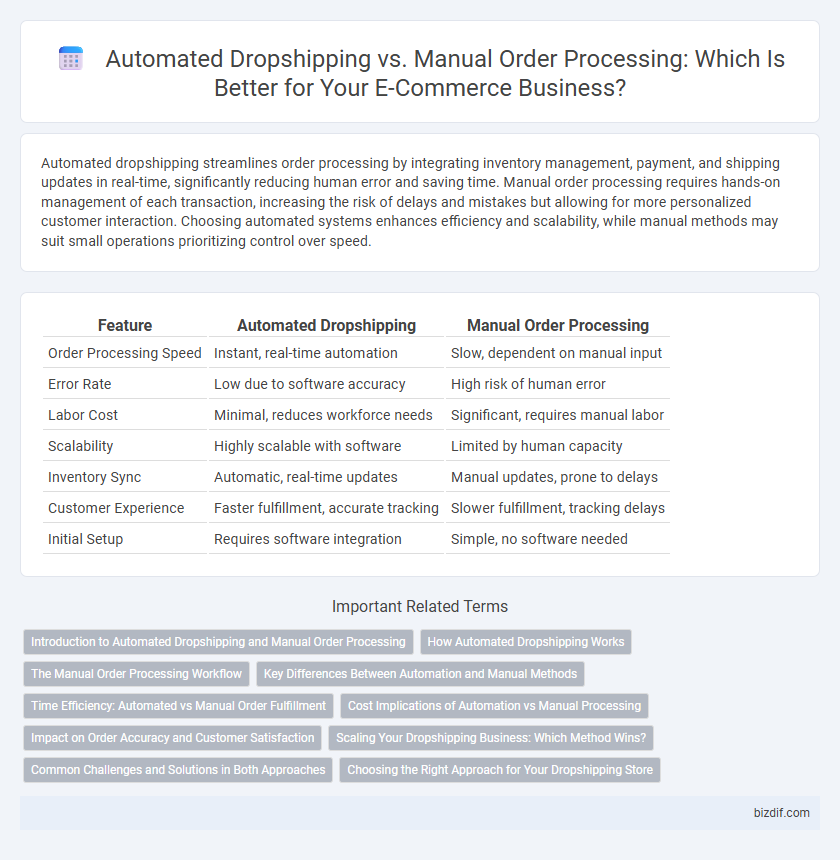Automated dropshipping streamlines order processing by integrating inventory management, payment, and shipping updates in real-time, significantly reducing human error and saving time. Manual order processing requires hands-on management of each transaction, increasing the risk of delays and mistakes but allowing for more personalized customer interaction. Choosing automated systems enhances efficiency and scalability, while manual methods may suit small operations prioritizing control over speed.
Table of Comparison
| Feature | Automated Dropshipping | Manual Order Processing |
|---|---|---|
| Order Processing Speed | Instant, real-time automation | Slow, dependent on manual input |
| Error Rate | Low due to software accuracy | High risk of human error |
| Labor Cost | Minimal, reduces workforce needs | Significant, requires manual labor |
| Scalability | Highly scalable with software | Limited by human capacity |
| Inventory Sync | Automatic, real-time updates | Manual updates, prone to delays |
| Customer Experience | Faster fulfillment, accurate tracking | Slower fulfillment, tracking delays |
| Initial Setup | Requires software integration | Simple, no software needed |
Introduction to Automated Dropshipping and Manual Order Processing
Automated dropshipping utilizes software tools to streamline order placement, inventory management, and customer communication, significantly reducing manual effort and minimizing errors. In contrast, manual order processing involves individually handling each order by contacting suppliers, updating tracking information, and managing stock availability, which can be time-consuming and prone to mistakes. Choosing automated systems enhances scalability and operational efficiency compared to traditional manual workflows in dropshipping businesses.
How Automated Dropshipping Works
Automated dropshipping streamlines order processing by integrating e-commerce platforms with supplier systems, enabling real-time inventory updates and instant order placements without manual intervention. This system uses APIs or specialized software to automatically route customer orders directly to suppliers, reducing errors and minimizing fulfillment time. By automating key tasks such as order tracking, payment confirmation, and shipment notifications, businesses can significantly enhance operational efficiency and scalability.
The Manual Order Processing Workflow
Manual order processing in dropshipping involves the retailer receiving customer orders, manually forwarding these details to suppliers, and tracking shipments without automated tools. This workflow requires careful coordination to ensure accurate invoice generation, inventory updates, and timely communication with both suppliers and customers. Despite being labor-intensive, manual processing allows for greater control over order customization and personalized customer service.
Key Differences Between Automation and Manual Methods
Automated dropshipping streamlines order processing through software integration, reducing human errors and significantly speeding up fulfillment times compared to manual order processing, which relies on human input and is prone to delays and mistakes. Key differences include real-time inventory updates and instant order tracking offered by automation, whereas manual methods require constant monitoring and manual data entry. Automation enhances scalability and operational efficiency, while manual processes may offer more personalized control but often at the cost of increased labor and slower response times.
Time Efficiency: Automated vs Manual Order Fulfillment
Automated dropshipping significantly reduces order fulfillment time by instantly processing orders through integrated software, eliminating manual data entry errors and delays. Manual order processing requires extensive time for each step, including verifying inventory, entering customer details, and confirming shipments, leading to slower overall turnaround. Leveraging automation tools accelerates order handling, improves accuracy, and increases scalability for dropshipping businesses.
Cost Implications of Automation vs Manual Processing
Automated dropshipping significantly reduces labor costs by streamlining order processing through software, minimizing human errors and accelerating fulfillment times. Manual order processing often entails higher operational expenses due to increased labor hours, slower order management, and greater risk of costly mistakes. While automation requires upfront investment in technology, it ultimately lowers per-order costs and enhances scalability compared to manual workflows.
Impact on Order Accuracy and Customer Satisfaction
Automated dropshipping significantly improves order accuracy by minimizing human error through real-time inventory syncing and instant order transmission to suppliers. This technological integration enhances customer satisfaction by ensuring faster processing times and reducing the likelihood of incorrect or delayed shipments. In contrast, manual order processing often leads to miscommunication, slower response rates, and higher error margins, negatively affecting the overall customer experience.
Scaling Your Dropshipping Business: Which Method Wins?
Automated dropshipping streamlines order processing by integrating inventory management, payment, and shipping, enabling faster scaling with reduced human error and operational costs. Manual order processing requires meticulous attention but offers greater control for customization and handling complex orders, potentially limiting growth speed. For scaling your dropshipping business efficiently, automation wins by enhancing productivity, reducing delays, and supporting higher order volumes without proportional increases in labor.
Common Challenges and Solutions in Both Approaches
Automated dropshipping streamlines order processing by integrating with suppliers' systems, reducing manual errors but may face challenges like software glitches and limited customization options. Manual order processing allows greater control and customization but often results in slower fulfillment, higher risk of human error, and increased labor costs. Solutions include implementing reliable automation tools with ongoing technical support and training staff for accuracy in manual tasks to balance efficiency and precision in order fulfillment.
Choosing the Right Approach for Your Dropshipping Store
Automated dropshipping streamlines order processing by integrating with suppliers through software, reducing errors and saving time, which is ideal for high-volume stores. Manual order processing allows for greater control and customization but can be time-consuming and prone to human error, making it suitable for niche stores with lower order volumes. Selecting the right approach depends on your store's size, product complexity, and desire for efficiency versus personalized control.
Automated Dropshipping vs Manual Order Processing Infographic

 bizdif.com
bizdif.com